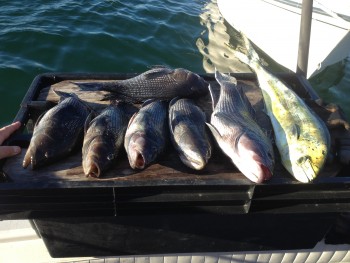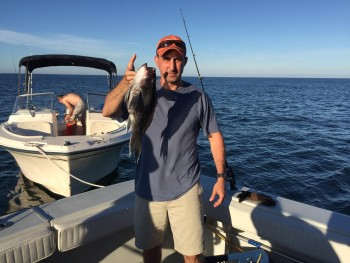Some dates are indelible: birthdays, the first day of spring, weddings, graduation. And they certainly can’t be ignored when the anniversary falls on a nice round number. This year we observe 40 years of the Magnuson-Stevens Act (MSA), a milestone in the history of the management and conservation of U.S. fisheries.
Congress passed the original act on April 13, 1976, initially to protect our nation’s marine resources against foreign fleets. Beginning in the 1960s, American fishermen saw a steady decline in catches due to increasing fishing pressure from overseas vessels making aggressive forays into U.S. waters. Fortunately a bipartisan Congress worked with commercial and recreational fishermen, scientists and others to draft a law that would protect national interests through a management system that protected depleted species. Over the years this vision has led to a number of major improvements in fishery management along our coasts.
Bycatch Reduction
Fishermen used to think bycatch of unwanted species was an inevitable part of their livelihood. But over the years the MSA has sharply reduced the amount of unwanted catch. Strategies included turtle excluder devices (1989), declaring bycatch reduction a national standard for all fisheries (1996), placing trained observers on vessels to accurately monitor bycatch (1999), reducing bycatch mortality by introducing circle hooks that are less likely to be swallowed and could be easily removed from an animal’s mouth (2004), and calling for “weak” hooks that would release heavy bluefin tuna accidentally caught on lines set for yellowfin (2010). By limiting the amount of unwanted species in the catch, these and related innovations have made U.S. fisheries some of the most efficient and productive in the world.
Essential Fish Habitat
In 1996, Congress amended the MSA to better manage fisheries by identifying and protecting Essential Fish Habitat (EFH). Under this regulation the National Oceanic and Atmospheric Administration must compile new data and maps of underwater habitats every five years to keep up with environmental changes. Deep-sea corals and sponges were included in the EFH provisions in 2006 and are now also protected from harmful fishing practices. Even bycatch regulations were revised to count corals and sponges among protected species. The inclusiveness of the MSA’s definition of essential habitat—”those waters and substrate necessary to fish for spawning, breeding, feeding, or growth to maturity”—now protects over 800 million acres from harmful fishing practices, coastal development, energy exploration, and other human-induced activities.
Along the way, the MSA’s flexible approach to fisheries management has led to other advances such as smarter types of gear and the use of the best available science to inform on-the-water practices.
Although the MSA is not perfect, all of the management steps taken over the past 40 years because of the law have contributed to rebuilding stocks and improving the health of our oceans. But above all the evolution of this law has kept alive an enduring tradition, older than our nation: generation after generation of men and women making a living as their families did before them.
Today, as a result, coastal fishing communities are an integral part of the marine ecosystem, and they play a critical role in fisheries management and ocean conservation. Our commercial and recreational fishing traditions knit together the economic, social and ecological fabric of our waterfronts. Community-based fishermen not only provide a reliable supply of locally caught seafood and outdoor recreation opportunities that generate revenue for local economies, they are also a vital voice for resource conservation and sustainable management of fisheries.
Because these fishing communities are, in effect, part of the larger marine ecosystem, we need the MSA and related legislation to prioritize healthy fish populations that will provide community-based fishermen with sustained access to abundant resources—now and into the future.
Forty years of the Magnuson-Stevens Act have produced impressive results:
- In 2014, federal officials announced that the number of stocks subject to overfishing or being overfished dropped to all-time lows. Just 8 percent of managed stocks remained on the overfishing list, along with 16 percent of stocks considered overfished. All of these are in rebuilding plans. That same year, our nation’s commercial and recreational fisheries added about $200 billion to the U.S. economy and accounted for 1.7 million jobs.
- The National Marine Fisheries Service is shifting to a more holistic approach for managing species and their habitats. This will mean more integrated and effective fisheries management for the future.
- Countries in Europe and elsewhere around the world are using the MSA as a model for their own fisheries management systems.
We need to maintain the momentum of this bipartisan success story by ensuring a reauthorized MSA meets the needs and challenges of fishermen now and into the future. The Marine Fish Conservation Network stands behind this legislative effort with four goals.
First, Congress must reaffirm and defend the Act’s conservation requirements and its strong science-based management approach. This includes the law’s rebuilding provisions and its requirements for annual catch limits and accountability measures. These provisions must also support mandates for compliance with all federal environmental laws and regulations such as the National Environmental Policy Act and the Endangered Species Act.
Second, Congressional reauthorization of the MSA must promote policies to strengthen our nation’s working waterfronts and community-based fishermen. The Act’s renewal can do this by ensuring healthy oceans and fisheries for community-based fishermen and the generations that will follow them.
Third, we must move to a more comprehensive fisheries management system that protects marine ecosystems and the habitats that fish depend on for survival. Measures to minimize bycatch and better incorporate science should continue as part and parcel of the MSA.
Finally, the renewed Act should ensure funding and strengthen mechanisms that improve assessment, monitoring and enforcement of the law. Better data on stocks and catch accounting for all major fisheries, through on-board observers or electronic monitoring of catches, will go a long way toward implementing this goal.
So this April 13, if you care about fish and the men and women who put them on the table, take a moment to celebrate the achievements of the Magnuson-Stevens Act over the past four decades. Better yet, you can stand behind reauthorization measures that extend its management protections to coastal communities and the traditions they embody, improve the legislation’s effectiveness through vigorous implementation and enforcement, and bolster healthier marine ecosystems. And while you are celebrating past achievements and looking forward to future goals, make sure the candles on your fish cake include “one to grow on.”




